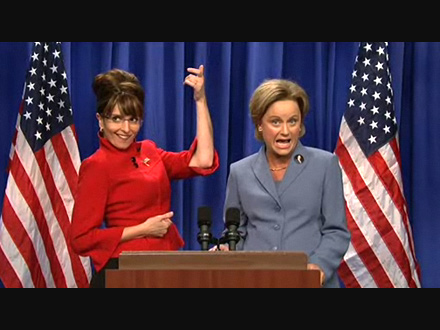Even Mud Has The Illusion of Depth: A McLuhanesque Reading of Sarah Palin
Ann McKinnon / Okanagen College

How do we read the phenomenon of Sarah Palin, John McCain’s choice of Vice Presidential running mate for the upcoming US federal election? I am going to suggest that we read Palin’s appearance — and disappearance — from the national stage via Marshall McLuhan’s famous aphorism, the medium is the message. I think it is safe to assume that many attempt to understand Sarah Palin by the content of what she says, for meaning-making humans desire to know who she is and what she knows and stands for, especially given that Americans need to make important decisions regarding the future of their country. At first, Palin’s arrival on the scene helped Republicans gain in the polls, with the explanation that she is someone that Republican women can identify with and – this is a stretch — some pundits saw her as a replacement for disaffected women who would have voted for Hilary Clinton. However, since her first arrival on the national stage, her rating approval has dropped precipitously. Why?
One argument is Palin’s disastrous first interviews, specifically with Charles Gibson on ABC1 and later Katie Couric on CBS2 as the principle reason for her slide in approval ratings. In the first interview with Gibson in September, Palin revealed herself as entirely ignorant of foreign affairs and domestic policy. Immediately after the Gibson interview, on Saturday Night Live3 Tina Fey parodied Sarah Palin to such excruciating satirical truthfulness that Palin may not survive the ridicule.4
Many did not see the SNL skit on television; rather, they saw it after it went viral. Arguably, of the millions of viewers that saw the skit, especially those outside of the United States, many saw it first via email, on YouTube, and then later on the SNL webpage.
Immediately after the Gibson and Couric interviews and the SNL parody of Palin, she disappeared from the public view. Indeed, Palin has yet to hold a major press conference after McCain announced her as his running mate5. McCain representative Michael Goldfarb said that Palin would do at least one news conference before Election Day. That could mean that the person who could potentially lead the (so called) free world will have done one national press conference before being sworn into office. On the other hand, the Democratic vice presidential nominee, Joe Biden, has given more than 89 national and local interviews. Clearly, her handlers pulled Palin, like a bad vaudevillian, off stage with a cane. When she met with foreign leaders in New York last week, the campaign initially would only allow photographers near – no microphones to catch rogue comments about invading Russia and shooting bears from a plane. Indeed, we have seen more parodies of Palin than we have seen the actual Palin,6

So what happened? Was it merely the content of what Palin said in the Gibson and Couric interviews — both parodied on SNL — that sunk her, or was something else at work? When Marshall McLuhan said the content of a new media is the old media, what he meant was that the old environment – let’s say television — becomes the content of the new environment, in this case the internet and specifically YouTube. For example, the medium of language is its own message: language is the first technology for letting go of one’s environment in order to grasp it in new ways. When humans speak for the first time, they are not only naming the world, but outering (sic) their inner desire – leaving their bodies and creating new environments. McLuhan’s second aphorism, the medium is the massage, was meant to forestall his original version, the medium is the message, from becoming a cliché and to further emphasize the original intent of his aphorism, which is that all media creates new environments.
[youtube]http://www.youtube.com/watch?v=A7GvQdDQv8g&feature=related[/youtube]
The old environment becomes content for the new environment. Formal causes inherent in media operate on our physical senses, the senses that they extend. Glasses are an extension of our eyes. The wheel is an extension of the foot. Clothing is an extension of the skin. Electrical circuits or electro magnetic technology is an extension of our nervous system. Digital technology outs our genetic code7, and the effects and affects of these technologies come from their form, not their content. The medium itself is the ultimate message, for by outering our inner selves or our senses, the technology creates new embodied environments.
Think of it this way: in his book Mechanical Bride: The Folklore of Industrial Man, McLuhan asks: can the feminine body keep up to the demands of the textile industry?8 We know that models are excruciatingly thin today, and when we think of the current rise of anorexia amongst girls, women and the models themselves, the answer is no, the female body cannot keep up to the demands of the textile industry. It is not so much a case of cause and effect. The fashion industry does not cause disordered eating, but rather the fashion industry and its messenger advertising, by creating new environments for our skin, creates conditions into which our bodies simply cannot fit. Our bodies attempt to morph to fit the demands of the fashion and adverting environments.
We can read this is via “content” analysis: advertisers who use thin models which in turn create the appetite for anorexia9 for we read the content of the ad – the picture – and think we must be thin. The other reading regards form: we create with fashion new mediated environments for our skin, skimpy environments, as it were. The world truly is shrinking and so are our clothes. When McLuhan spoke about meaning, which he rarely did, he spoke about meaning in terms of relationship. What is the relationship of one form – the televised interview that morphs into the televised satire that then morphs into a YouTube clip sent via email? And, can the content – the meaning of Plain – keep up to the demands of the form, viral media? Nope. It will morph to fit the content of the new medium. Further, each new medium is by definition always already subversive. For new media construct relationships in new ways. The mass in mass communications defines how we codify relationships, in this case, by infection or virally.
The SNL skit is satirical. The Canadian literary theorist Northrop Frye called satire militant irony, for the otherwise powerless can make creative use of power imbalances in order to empower him or herself. Indeed, McLuhan said that he was a satirist and argued that all great art must be satire10. In this case, legitimate interviews are satirized by a television show, but once posted on YouTube, the very form of the media further satirized the content. YouTube is satiric, for anonymous individuals take the clips and re-contextualize them for their own ends.
[youtube]http://www.youtube.com/watch?v=QFU-ApZ-HZQ&feature=related[/youtube]
Television reception is now far beyond the control of its producers. In this clip, you have an example of a detour of the signifier, where each narrative operates satirically, for it breaks a singular reading. YoutTube follows in the tradition of bardic culture, which mostly consisted of people pointing and laughing at power. Popular culture pre-Gutenberg technology was the culture of the people, and in McLuhan’s digital universe, it is once again. This is, in part, what he meant by the Global Village.
For example, consider the now famous case of Chevrolet and their user generated ad campaign. In 2006, the automotive giant offered consumers a chance to make their own Chevy Tahoe ads, complete with an on line kit, to later share via email. 30,000 of the ads were generated, and parodies of Chevy sprouted up like daisies. In them, the consumer/artists blamed Chevy for everything from global warming, to the Iraq war, to American’s maladjusted sexual image, all shared first by email, later aired on YouTube. Of course, McLuhan the satirist would have predicted this: that is what people do with any form of communication given half a chance.11
The medium is the message is a metaphor for metamorphosis in McLuhan. The old media, television, cannot keep up to the demands of the new digital economy, in this case YouTube, and TV necessarily morphs to fit the new electronic spatial conditions. The name of this online journal, “FlowTV,” describes the flow of one program or web site endlessly into another. However, it is also a spatial metaphor or “floe as in an ice flow or archipelago spaces — contested spaces — that do not resolve into meaning. The SNL skit was certainly satiric in its content, but once it goes viral, it is also satirical in its form. It flows. What YouTube ultimately makes fun of is power, regardless of its content. It represents multiple and heterogeneous sources of meaning-making that cannot be subsumed by homogenizing forces. YouTube itself does not always offer the most enlightening viewing; nevertheless, in this case, the ultimate satirical act has occurred, and Sarah Palin will never reemerge as “herself,” whoever that is. When Tina Fey’s Palin went viral, she became much more real that Palin is herself, so much so that the parody of Palin drove the actual Palin under ground. The medium is the message. We don’t need the spin doctors and those that analyze their spinning in order to unpack the question, “who is Sarah Palin?” As McLuhan memorably said, even mud has the illusion of depth. Sarah Palin doesn’t exist. Tina Fey for Vice President.
Image Credits:
1. Tina Fey Poses as Sarah Palin
2. Sarah Palin Corn Maze
Author Bio:
Ann McKinnon is the Chair of Sociology and Women’s Studies at Okanagan College in Kelowna, British Columbia, Canada. Her research interests are feminist, psychoanalytic and media theories and she has written on Canadian television, Marshall McLuhan, Jacques Lacan and David Cronenberg.
Please feel free to comment.
- September 11, 2008 [↩]
- September, 2008 [↩]
- September 14, 2008 [↩]
- Tina Fey as Palin chirping “I can see Russia from my house,” may turn out to have as much or more longevity as any serious political utterance in the last decade. [↩]
- although she did appear again with Couric [↩]
- There has, however, been a sighting of Palin in a cornfield. A farmer in Ohio has carved up his 16 acres of corn into the likeness of the Republican Vice Presidential Candidate – a kind of corn maze to further confuse undecided voters, I guess. Or if we read it formally a la McLuhan instead of via its content, it can only be understood as, well, corny. [↩]
- note that we have gone further in to the deep space of the body. [↩]
- McLuhan 93 [↩]
- and I mean appetite, for although anorexics may not eat food, it is also a problem of material consumption [↩]
- Theall 189 [↩]
- Slavoj Zizek states that the first thing fascists do is steal enjoyment. Satire is one way to take it back. [↩]
what’s frightening to me is that the SNL sketches are more “reinactments” rather than “parodies.” Sarah Palin’s folksiness feels good but means nothing.
I definitely agree with the last comment. The new emphasis on ‘content’ and ‘reinactment’ rather than scripted material makes this article not only more timely but also more frightening. I think that McKinnan does an excellent job tracing how content (in this case, Sarah Palin) is shaped through the new mediums, and that these are necessarily satirical. In this way, we should have had no doubts that Palin would be criticized satirically as she would have been a rich target regardless of who she was on SNL. As an aside, I was certain that the universe was going to implode when Tine Fey and Palin were in the same place at the same time.